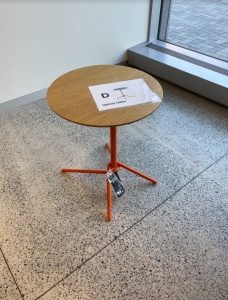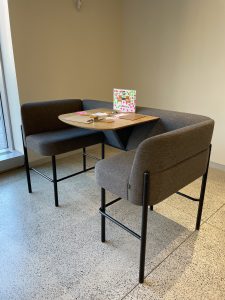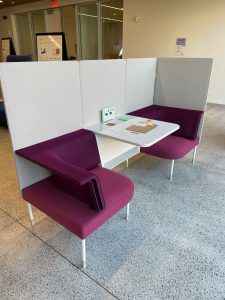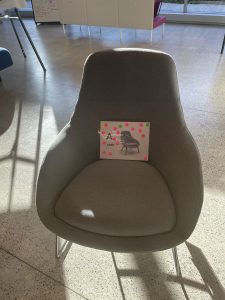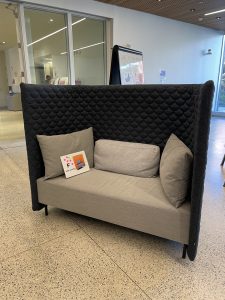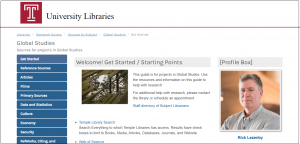Last week I shared some highlights of the Envisioning our Future interview project with TULUP staff. In this post I begin to pull together themes that emerged over the course of the project’s three phases: organizational communication, change and connection.
We began this research journey in early 2019 as library staff at Paley Library were planning the move to Charles. In proposing this assessment project to the Association of Research Libraries, I referenced the Atheneum21 report on successful implementation of digital strategies in libraries. Success, they said, is about the people and the culture, not the technologies themselves. This new space, Charles Library, would be full of exciting technologies for collaboration and research, for staff and for users. We wanted to explore how our people, the TULUP staff, imagined the spaces changing their work. What are the opportunities, and what are the envisioned challenges?
The research design was qualitative; semi-structured interviews. We asked about the spaces that staff used for work as individuals, with colleagues and users, and how they felt supported in making those changes.
In reflecting on the new space, one interviewee says,
In order to survive and thrive in the new building, we’re going to have to work together more closely. I expect that some people will be resistant to that sort of change, but I thing by and large people, especially in the beginning, will be receptive, because we’ll be in the new, really unique space. (p. 9)
I think it will be a nice opportunity for me to chat with some people that I don’t normally interact with” (p. 9)
From: Envisioning our Future, Report on Findings and Staff Conversations, August 12, 2019
In Phase II we conducted a second round of interviews about six months after the move to Charles, but just before the pandemic hit. Findings were reported in July 2020 as The Future in Now: How We’re Working at Charles. Not surprisingly, change and communication were central themes emerging from this round of interviews. We noted that clear and regular communication about operations during the change was key – staff needed ready access to information about known problem areas in the building and technology. Staff working on the front lines, using instruction and consultation spaces, and helping users at the service desks, felt particularly frustrated by unexpected disruptions. Noise! Technology glitches! Help!
But staff recognized these early days as transitional and once again, there was a sense of optimism about the future:
Change is hard. I feel like in a couple of years it’s going to be fine. I think sometimes it’s a little demoralizing that people aren’t seeing the potential of the building. They’re expecting everything to be perfect right away.
After three, four months I’m starting to feel like this is where we are. This is our future. (p23)
We reported on perceived changes in organizational culture. Many interviewees spoke to the new physical spaces necessitating a shift in how staff work together, “from shared workspaces to increased need for inter-departmental cooperation in providing positive service experiences for our users.”
I think that we need to be talking a lot more about how to create a workplace culture that is going to work, where we have respect for each other’s boundaries and space in a way that we’ve never had to talk about before.
From: The Future is Now: How We’re Working at Charles, July 23, 2020
We were getting used to the new spaces, and finding out how it worked for us most effectively.
But of course the story does not end there. Just as we were wrapping up our interviews for Phase II of research in spring of 2020, the library buildings closed due to COVID. As an organization, we faced a new kind of hardship that brought us together to solve challenges, but divided us in other ways. Envisioning our Future: The Pandemic Changed Everything (completed in March 2022) provides a third “installment” to this exploration into how space supports out work. Again we asked staff, from across the library/press system, about physical and virtual spaces, onsite and remote. This hybrid work environment adds an additional dimension to our use of space, particularly in how we communicate and collaborate with colleagues.
Key findings relate to these “cultural” implications. For instance, several staff described a perceived loosening of collegial ties, particularly with those outside their immediate department or project teams.
I worry what Covid has done to our cohesion as a staff and as an organization. I worry that it has taken an organization that was already pretty siloed and made it even more siloed because you’re not having those chance encounters. (p.15)
There’s a lot of flexibility in our schedule and it’s very nice for life. But it’s weird for any kind of collegiality. (p.15)
From: Envisioning our Future Phase III: The Pandemic Changed Everything, March 29, 2022
We’ve now been envisioning our future for three years. What a privilege it has been to work with three great research teams, to conduct, read and reflect on 86 interviews, and to get at this deep level of organizational self-study over three years. As we look to the future now, we need to look closely at how the hybrid work environment impacts our organization – from basics of technology and communication practices to how we collaborate effectively in our work. How do we move forward together, in unison and in service to the University? How do we create a sense of community and organizational cohesion, particularly as we onboard new staff members? And importantly, how do we best support one another during these periods of stress and disruption – as we learn that this change is not temporary, but a constant.



